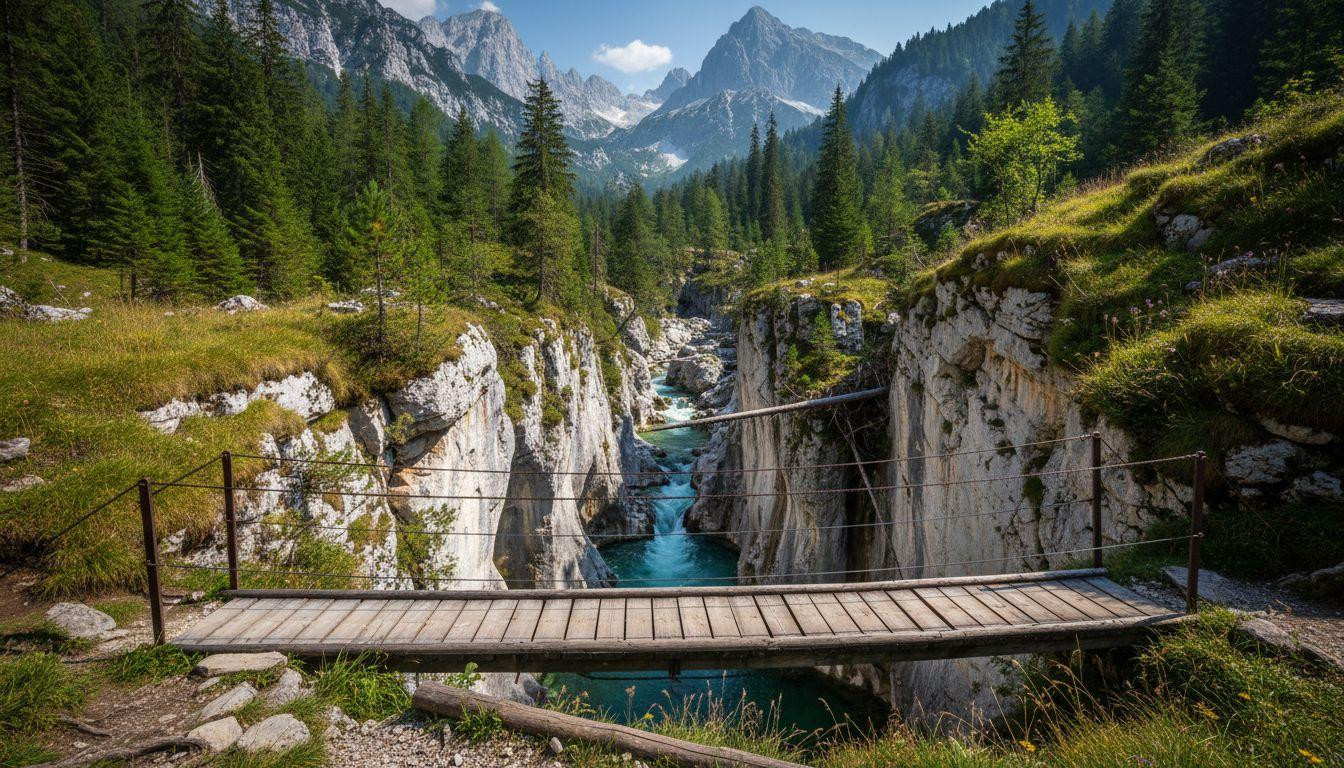Deep in Slovenia’s Julian Alps, where limestone meets sky at impossible angles, lies a geological paradox that defies comprehension. Mlinarica Gorge stretches just 1 meter wide while plunging 80 meters into the earth. This razor-thin crack in the mountains creates Europe’s most dramatic width-to-depth ratio in an active river system.
The emerald Mlinarica stream carves through solid rock with surgical precision. Water rushes through walls so narrow they block midday sun, creating perpetual twilight at the gorge floor. Unlike Slovenia’s crowded Vintgar Gorge with its wooden walkways and 300,000 annual visitors, Mlinarica remains genuinely wild and almost inaccessible.
Where limestone splits to impossible depth
The Mlinarica originates between peaks Prisojnik (8,356 feet) and Razor (8,530 feet) in Triglav National Park. Snowmelt cascades 984 feet over just 0.43 miles, creating erosive force that carved this geological impossibility over millennia. The stream exploited vertical fracture systems in Triassic limestone, where water dissolves rock more readily than surrounding dolomite.
Official Triglav National Park documentation confirms the gorge reaches maximum depths of 70-80 meters. The narrowest sections compress to exactly 1 meter wide, creating a staggering 1:80 width-to-depth ratio. For comparison, France’s famous Verdon Gorge achieves 1:117 ratios only in isolated sections, while Slovenia’s other gorges rarely exceed 1:25.
Wedged rocks create natural bridges spanning the chasm. Waterfalls plunge into pools invisible from above. The gorge remains virtually inaccessible due to unstable limestone and frequent rockfalls that have altered its appearance over recent years.
The view from above
What you see from the bridge
A marked trail leads 0.75 miles from Trenta Valley parking to a suspension bridge viewpoint. Here, emerald water contrasts against stark white limestone walls descending into shadow. The perspective reveals the gorge’s impossible narrowness, where extended arms could nearly touch both sides while standing above an 80-meter drop.
Morning light illuminates the upper walls while the gorge floor remains in perpetual twilight. The visual paradox triggers vertigo: your mind struggles to process such extreme vertical compression.
The sound that echoes
Water rushing through the narrow slot creates a constant whisper that echoes off limestone walls. Cool alpine air funnels through the gorge, carrying the fresh scent of snowmelt and damp stone. The acoustic chamber effect amplifies every sound into haunting reverberations.
Unlike developed tourist sites, human noise remains absent. Bird calls from surrounding pine forests provide the only soundtrack beyond rushing water. This natural silence enhances the gorge’s wild character that similar limestone formations in other national parks have lost to development.
Hiking the Soča trail
The 15-minute walk from parking
From the designated parking area near Soča River bridge, a well-marked path requires just 15 minutes to reach the main viewpoint. The trail gains 164 feet elevation through alpine meadows dotted with seasonal wildflowers. Recent trail maintenance in 2025 improved accessibility without compromising the area’s natural character.
Photography opportunities abound from the suspension bridge. The contrast between narrow limestone walls and bright emerald water creates Instagram-worthy compositions. Early morning visits (7-9am) offer the best lighting conditions and guaranteed solitude.
June to September window
The gorge viewing trail operates reliably from June through September when snow clears from higher elevations. July water temperatures reach 55-60°F, while air temperatures average 75°F during peak summer. November visitors miss the dramatic snowmelt flows but gain clearer views of geological structures.
Peak water flow occurs during May-June snowmelt, creating the most spectacular waterfall displays. However, remote mountain access requires careful seasonal planning for optimal conditions.
The gorge that tourism forgot
While Vintgar Gorge accommodates visitors with constructed walkways and entry fees, Mlinarica’s extreme dimensions preserve its untamed essence. The 1-meter width combined with 80-meter depth creates safety conditions that prohibit commercial canyoning operations. Technical rescue becomes virtually impossible in the narrowest sections.
This inaccessibility serves as natural protection. Tourism officials in Bovec report fewer than 5,000 annual visitors reach Mlinarica’s viewpoints, compared to over 300,000 at nearby Vintgar. The preserved wildness attracts serious hikers seeking authentic alpine experiences beyond Slovenia’s developed attractions.
Local accommodation ranges from $40-80 per night in Bovec area guesthouses, while meals average $12-18 in traditional mountain inns. Free gorge access contrasts sharply with commercialized alternatives throughout the Alps.
Your questions about Mlinarica Gorge answered
Can you walk through Mlinarica Gorge?
No commercial or recreational access exists within the gorge itself. The 1-meter width combined with unstable limestone walls creates unacceptable safety risks. Park authorities prohibit entry beyond designated viewpoints. Only scientific research teams with specialized equipment may enter under strict permits.
How does it compare to other Slovenian gorges?
Mlinarica offers the most extreme width-to-depth ratio in Slovenia. Vintgar Gorge provides easier access with wider passages (10-20 meters) but attracts massive crowds. Tolmin Gorge features similar limestone formations but remains 2-10 meters wide throughout. Mlinarica’s wild character surpasses both developed alternatives.
What else is near Mlinarica?
The Soča River source lies 2.5 miles upstream, accessible via extended hiking trails. Bovec (14 miles away) offers rafting, kayaking, and paragliding activities. Trenta Valley provides access to multiple alpine hiking routes throughout Triglav National Park’s 340 square miles of protected wilderness.
Standing above this geological impossibility, watching emerald water disappear into limestone shadows, you witness raw alpine power compressed into arm’s width. The gorge represents Slovenia’s wild heart, where extreme geology creates beauty too dangerous to fully explore yet too dramatic to ignore.
